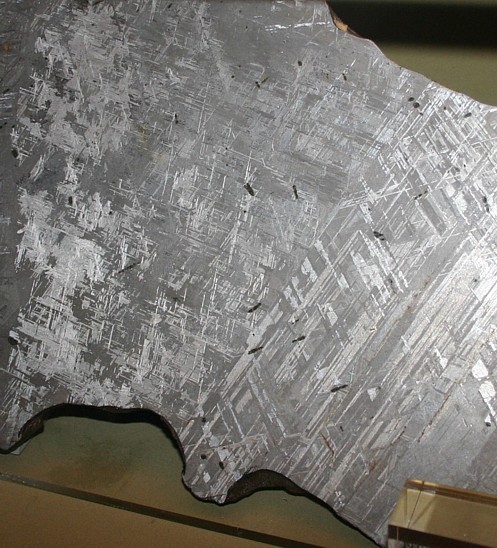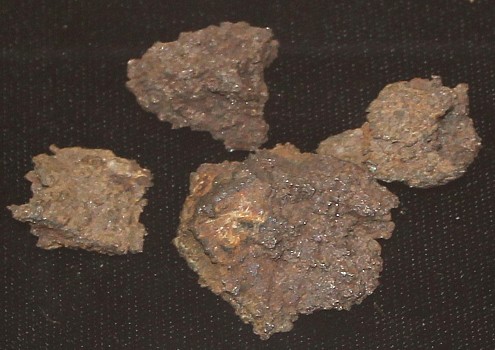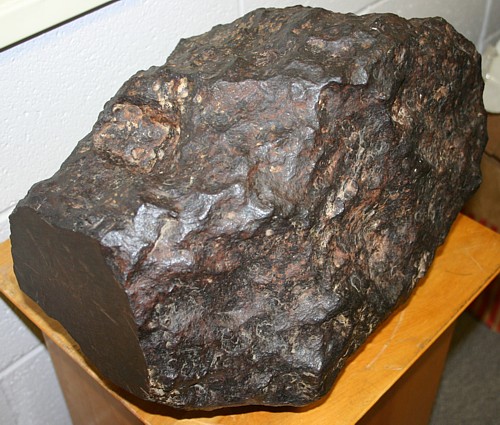|
.
Native Iron Mineral Facts:
Chemical Formula: Fe
Natural metallic iron is usually alloyed with
nickel or some other metal, or mixed with other iron compounds. Iron
from meteorites is also alloyed with nickel and small quantities of
cobalt, manganese, tin, chromium, sulfur, carbon, chlorine, copper, and
phosphorus.
Colors:
Iron or steel gray metallic.
Hardness:
4 to 5
Density: 7.3
to 7.8
Cleavage:
No
cleavage observable.
Crystallography: Isometric - Octahedral
Hackly fracture; it is also
malleable and ductile. Generally massive, and with a somewhat granular
structure.
Luster:.
Metallic
luster. Opaque.
|

Meteorite Widmanstatten pattern close up |
|
Composition,
Structure and Associated Minerals:
Metallic iron occurs as a mineral
in certain dolerites and basalts, but
is rare. Native non-metorite iron (Fe) occurs in small grains and large masses in the basalt at
Ovifak, Disko Island, W. Greenland, and at a few other points in Greenland,
and alloys consisting mainly of iron are found in the sands of some
placer gold
bearing rivers in New Zealand, Oregon and elsewhere. The native metal always
contains some nickel. The most common occurrence of iron, however, is
in meteorites. In these bodies also it is alloyed with Nickel. When
polished and etched with nitric acid, surfaces of meteoric iron exhibit
series of crystalization lines known as Widmanstatten figures, that are the edges of plates of
particles of
different composition. These are so arranged as to indicate
that the substance crystallizes in the isometric system..
Identification and Diagnostics
Soluable in mineral acids. Strongly magnetic. Distinguishable by its
malleability and its metallic luster.
Occurrence,
Localities and Origins:
Native iron, with always some nickel
and usually small amounts
of cobalt and frequently traces of copper, manganese, sulphur, carbon,
phosphorus, etc. Iron occurs very sparingly as terrestrial
iron, and in the form of meteorites. The largest iron masses known to be of
terrestrial origin are found, as inclusions in basalt at Disko Island and elsewhere
on the
on the west coast of Greenland, varying in size from small disseminated
grains to large masses ranging up to 25 tons in weight. Native iron has been noted in a few other localities
with a similar association. Native iron of terrestrial origin has been
reported as occurring in Brazil, Auvergne, Bohemia, and
in grains disseminated in basalt from the Giant's Causeway (Ireland), and
elsewhere. Nickel-iron alloys have been found
in the gold sands of New Zealand (awaruite), from Josephine County,
Oregon (josephinite) , and from the Fraser River, British Columbia
(souesite). Native iron may be formed by the alteration
of iron minerals, as in Eastern Canada.
Most meteorites contain native iron. The metal sometimes
forms practically the entire body of the meteorite, while at
other times it forms a cellular mass, inclosing grains of chrysolite, etc.
In the stony meteorites, iron is found disseminated through them
in the shape of small grains. Meteorites are to be recognized usually
by their fused and pitted exterior. At first they are coated with a
film of iron oxide, which disappears, however, on continued exposure
to the weather.
Meteoric iron is found in meteorites (masses which
have fallen from the outer atmosphere on to the surface
of the earth, and which may consist either entirely of
iron, or partly of
olivine and other silicates). Meteoric
iron is usually alloyed with nickel and small quantities of
cobalt, manganese, tin, chromium,
sulfur, carbon,
chlorine,
copper, and phosphorus. It rusts much less
readily than terrestrial iron, on account of the nickel
which it contains. The minerals olivine, enstatite,
augite, and anorthite have been found in meteorites. A phosphide of nickel
and iron (schriebersite) has also been
detected in meteorites, and also a sulfide of iron
(troilite), having the formula FeS..
Return to the
Mineral Collectors Information Page
|

Natural, Non-meteorite iron |
|



